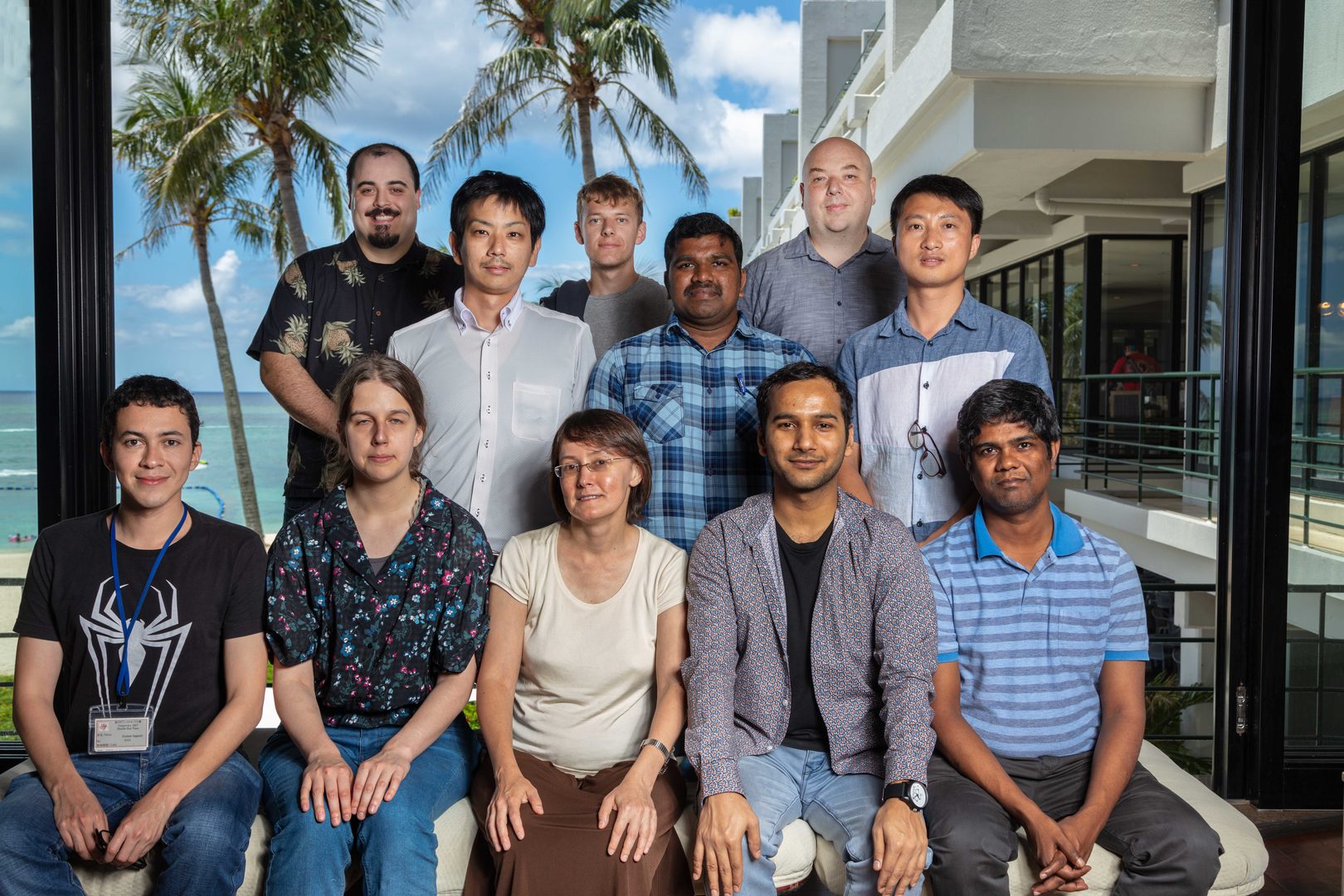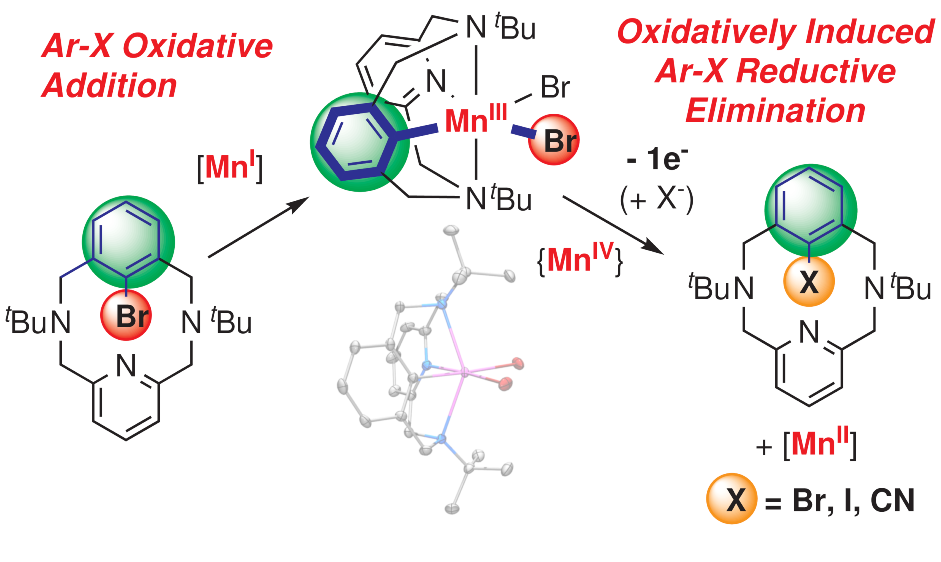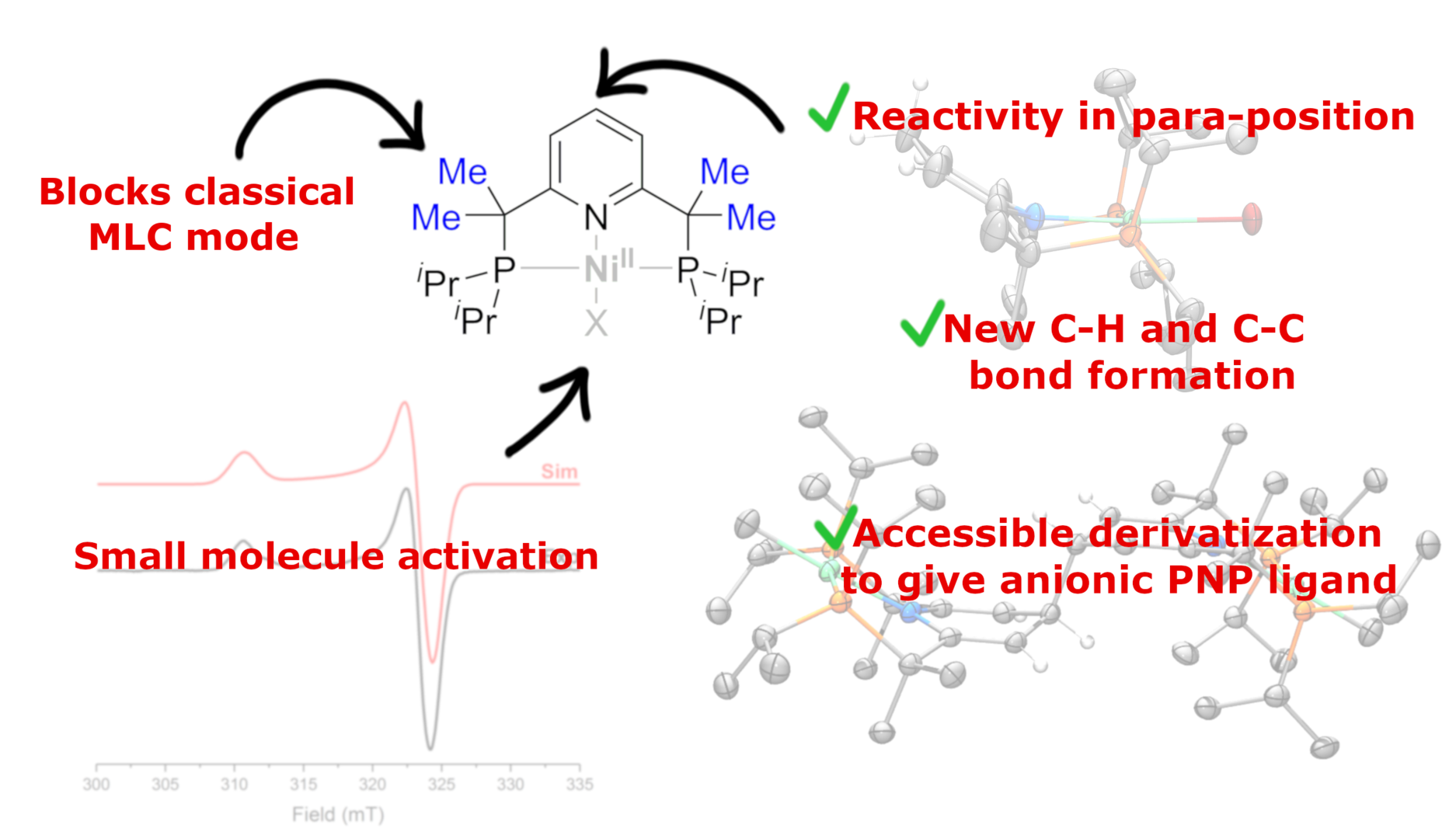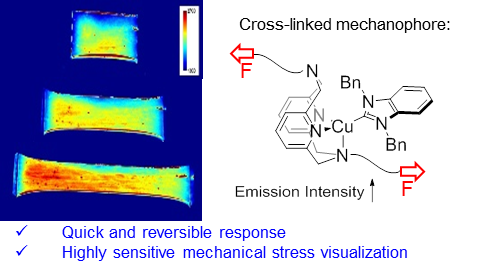FY2019 Annual Report
Coordination Chemistry and Catalysis Unit
Assistant Professor Julia Khusnutdinova

Back row: Sebastien Lapointe, Ayumu Karimata, James Gallagher, Govindarajan Ramadoss, Eugene Khaskin, Yu-Tao He.
Front row: Juan David Villada Morales, Tatiana Gridneva, Julia Khusnutdinova, Shubham Deolka, Wahidur Rahaman.
Abstract
During FY2019, we continued our research on the reactivity of manganese complexes with non-phosphine ligands in transfer hydrogenation. As a result, we reported the first example of a homogeneous Mn complex active in transfer hydrogenation of N-heterocycles. We also studied reactivity of Mn complexes in key bond breaking and bond making transformations such as reductive elimination and oxidative addition. In another project, we continue our study of Ni complexes with new pincer ligand to find that these ligands, previously though of as "truly non-innocent", in fact can undergo novel types of reactivity induced by tuning electronics at the metal center. Finally, we developed a highly sensitive polymer system showing fine mechanoresponse to stretching by changing photoluminescence intensity.
1. Staff
- Dr. Ayumu Karimata, Postdoctoral Scholar
- Dr. Wahidur Rahaman, Postdoctoral Scholar
- Dr. Govindarajan Ramadoss, Postdoctoral Scholar
- Dr. Yutao He, Postdoctoral Scholar
- Dr. Dilip Pandey, Postdoctoral Scholar
- Dr. Olga Gladkovskaya, Research Unit Technician
- Sebastien Lapointe, Graduate Student
- Shubham Deolka, Graduate Student
- Hoan Dinh, Graduate Student
- Alèria Garcia Roca, Research Intern
- Tatiana Gridneva, Research Intern
- James Gallagher, Research Intern
- Juan David Villada Morales, Research Intern
- Aleksandr Sorvanov, Research Intern
- Kyoko Chinen, Research Unit Administrator
2. Collaborations
2.1 Electron rich, bulky PNP ligands
- Synthesis and reactivity studies of complexes with electron-rich, bulky PNP ligands
- Type of collaboration: Joint research
- Researchers:
- Dr. Eugene Khaskin (STG, OIST)
3. Activities and Findings
3.1 Transfer hydrogenation by manganese complexes
Manganese is the third most abundant transition metal in Earth’s crust, and because of its cheap price and low toxicity, it is widely considered in homogeneous catalysis as a replacement for precious metal catalysts. However, in order to create an economically viable system, the ligand used to support Mn catalysts has to be inexpensive and easily available. For this reason, our group is focused on developing Mn catalysts with simple N-donor, non-phosphine ligand for hydrogen transfer catalysis.
Utilization of hydroxy‐substituted bipyridine ligands in transition metal catalysis mimicking [Fe]‐hydrogenase has been shown to be a promising approach in developing new catalysts for hydrogenation. For example, we have previously shown that MnI complexes with 6,6′‐dihydroxy‐2,2′‐bipyridine ligand are active catalysts for CO2 hydrogenation. In this project, we continue using simple bipyridine‐based Mn catalysts for transfer hydrogenation of ketones, aldehydes and imines. For the first time, we report Mn‐catalyzed transfer hydrogenation of N‐heterocycles. The highest catalytic activity among complexes with variously substituted ligands was observed for the complex bearing two OH groups in bipyridine. Deuterium labeling experiments suggest a monohydride pathway.
This work has been highlighted on the cover of ChemCatChem and the publication is an invited paper of the special issue “Women of Catalysis”.

3.2 Bond breaking and bond formation using manganese
Considering increasing interest towards manganese in catalysis, our group is also interesting in fundamental understanding of the key bond breaking and bond formation steps at the Mn center. However, up until now, the organometallic chemistry of Mn remains relatively underexplored. While a lot of progress has been done in understanding oxidative addition and reductive elimination processes in precious metal complexes, not much is known about such reactivity at Mn center, especially when considering high valent, paramagnetic species.
C–X bond reductive elimination and oxidative addition are key steps in many catalytic cycles for C–H functionalization catalyzed by precious metals; however, engaging first row transition metals in these overall 2e– processes remains a challenge. Although high-valent Mn aryl species have been implicated in Mn-catalyzed C–H functionalization, the nature and reactivity of such species remain unelucidated. In this work, we report rare examples of stable, cyclometalated monoaryl MnIII complexes obtained through clean oxidative addition of Ar–Br to MnI(CO)5Br. These isolated MnIII–Ar complexes undergo unprecedented 2e– reductive elimination of the Ar–X (X = Br, I, and CN) bond and MnII induced by 1e– oxidation, presumably via transient reactive MnIV species. Mechanistic studies suggest a nonradical pathway.
This publication was selected for the cover of the Organometallics issue.

3.3 Engaging pincer ligand in new types of reactivity
In the previous year, we reported a new tetramethylated PNP pincer ligand, in which the classical reactivity at the arms is blocked by presence of four methyl groups. Previously, we have shown that in the case of nickel halide complexes, it led to predominantly metal-based reactivity and stabilized unusual Ni(I) complexes.
Here, we continued to study nickel methyl and hydride complexes with this ligand. During our studies of the reactivity with various reductants, we found that by changing electronics at the metal, we can induce non-classical modes of dearomatization of the pyridine ring in the pincer complexes: via hydride attack or dimerization at the para-position.
In particular, the reduction of [(Me4PNPiPr)NiIIMe]B(ArF)4 with KC8 leads to the formation of a new C–C bond via dimerization of two complexes through the para position. UV-induced homolysis of the NiII–Me bond in [(Me4PNPiPr)NiIIMe]B(ArF)4 leads to the formation of a Me radical detected by radical traps and NiI intermediates that can be trapped in the presence of halide ions to give previously characterized, stable NiI halogen complexes. In addition, treatment of the bromo complexes [(Me4PNPR)NiIIBr]BPh4 with a powerful hydride source, LiBEt3H, leads to the reduction of the pyridine ring and the formation of NiII complexes with an anionic amide donor reduced pincer ligand, although aromatic NiII hydride complexes could also be obtained with a weaker hydride source. We have observed that steric bulk at the phosphine donors controls the reactivity of the resulting NiIIH complexes. While t-Bu-substituted [(Me4PNPtBu)NiIIH]Y (Y = BPh4, B(ArF)4) does not react with O2, the less sterically hindered iPr-substituted [(Me4PNPiPr)NiIIH]Y reacts instantaneously to give an unstable superoxide adduct that can be observed by EPR.

3.4 Highly sensitive stress detection using dynamic Cu-based cross-linkers
We continued our research on using dynamic macrocyclic pyridinophane ligand developed in our group for the design of stimuli-responsive polymers. During this year, we developed new copper complexes that are incorporated as cross-linkers into polybutylacrylate samples. The photoluminescence intensity of the resulting polymer films react sensitively to mechanical force: when the film is stretch, the intensity is increased, and when the film is released, the intensity returns quickly to the original value in a reversible manner. Such sensitivity is superior to previously reported systems based on classical organic mechanophores and it allows for direct visualization of mechanical stress by imaging methods.
This publication is highlighted on the cover of Chemical Communications.

4. Publications
4.1 Journals
-
Dubey, A.; Rahaman, S. M. W.; Fayzullin, R. R.; Khusnutdinova, J. R. "Transfer hydrogenation of carbonyl groups, imines and N‐heterocycles catalyzed by simple, bipyridine‐based MnI complexes" ChemCatChem 2019, 11, 3844-3852. DOI 10.1002/cctc.201900358
-
Sarbajna, A.; He, Y.-T.; Dinh, M. H.; Gladkovskaya, O.; Rahaman, S. M. W.; Karimata, A.; Khaskin, E.; Lapointe, S.; Fayzullin, R. R.; Khusnutdinova, J. R. "Aryl–X Bond-Forming Reductive Elimination from High-Valent Mn–Aryl Complexes" Organometallics 2019, 38 (22), 4409-4419, DOI: 10.1021/acs.organomet.9b00494
-
Lapointe, S.; Khaskin, E.; Fayzullin, R. R.; Khusnutdinova, J. R. "Nickel(II) Complexes with Electron-Rich, Sterically Hindered PNP Pincer Ligands Enable Uncommon Modes of Ligand Dearomatization" Organometallics 2019, 38 (22), 4433-4447. DOI: 10.1021/acs.organomet.9b00558
- Karimata, A.; Patil, P. H.; Khaskin, E.; Lapointe, S.; Fayzullin, R. R.; Stampoulis, P.; Khusnutdinova, J. R. "Highly sensitive mechano-controlled luminescence in polymer films modified by dynamic CuI-based cross-linkers" Chem. Commun. 2020, 56 (1), 50-53., DOI: 10.1039/C9CC08354E
4.2 Books and other one-time publications
Nothing to report
4.3 Oral and Poster Presentations
- Khusnutdinova, J. R., Deolka, S. & Rivada-Wheelaghan, O., Fayzullin, R. R., Lledós, A. & Comas Vives, A. Dynamic multimetallic assemblies to study metal-metal cooperation in organometallic chemistry, in Organometallic Gordon Research Conference, Newport, RI, USA, 2019.07.8
- Khusnutdinova, J. R., Deolka, S. & Rivada-Wheelaghan, O. Dynamic multi-metallic assemblies to study metal-metal cooperation in organometallic chemistry, in The 69th Conference of Japan Society of Coordination Chemistry, Nagoya, Japan, 2019.09.22.
- Deolka, S., Rivada-Wheelaghan, O., Fayzullin, R. R., Khaskin, E. & Khusnutdinova, J. R. Organometallic reactivity of heterobimetallic Pt/Cu complexes: bimetallic activation and the role of unsymmetrical ligand scaffolds. Japanese Society of Coordination Chemistry, Nagoya, Japan, 2019.09.22.
- Karimata, A., Patil. P., Lapointe, S., Khaskin, E., Fayzullin, R. R., & Khusnutdinova, J. R. Photoluminescent pyridinophane copper(I) complexes bearing NHC ligand and their applications in mechanical-stimuli responsive cross-linked polymer materials, Japanese Society of Coordination Chemistry, Nagoya, Japan, 2019.09.23.
- Dinh, M. H., Patil. P., Sarbajna. A. & Khusnutdinova, J. R. Facile and reversible double dearomatization of pyridines in non-phosphine Mn(I) complexes with N-S-donor pyridinophane ligand, in The 100th Annual Meeting 2020 of the Chemical Society of Japan, Chiba, Japan, 2020.03.22.
- Osborne, J., Lapointe, S. & Khusnutdinova, J. R. Application of Sterically Hindered Electron-Rich PNP CobaltComplexes in the Hydrogenation of Alkenes and Alkynes, in The 100th Annual Meeting 2020 of the Chemical Society of Japan, Chiba, Japan, 2020.03.22.
- Karimata, A., Patil. P., Lapointe, S., Khaskin, E., Fayzullin, R. R., & Khusnutdinova, J. R. Mechanoresponsive photoluminescence in cross-linked polybutylacrylates containing flexible (pyridinophane)Cu(NHC) complexes as mechanophores, in The 100th Annual Meeting 2020 of the Chemical Society of Japan, Chiba, Japan, 2020.03.23.
- Lapointe, S., Khaskin, E. & Khusnutdinova, J. R. Small Molecule Activation and Catalytic Reactivity of Rhodium andCobalt Complexes of Bulky PNP Ligands in The 100th Annual Meeting 2020 of the Chemical Society of Japan, Chiba, Japan, 2020.03.23.
- Deolka, S. & Khusnutdinova, J. R. Organometallic reactivity of heterobimetallic Pt/Cu complexes:bimetallic activation and the role of unsymmetrical ligand scaffolds in The 100th Annual Meeting 2020 of the Chemical Society of Japan, Chiba, Japan, 2020.03.24.
5. Intellectual Property Rights and Other Specific Achievements
Nothing to report
6. Meetings and Events
6.1 Seminars Hosted
1. "Activation of Dihydrogen by Molecular Hydrides of Electropositive Metals"
- Date: June 7, 2019
- Venue: OIST Campus, Lab 3, Level C (C700)
- Speaker: Prof. Jun Okuda (Institute of Inorganic Chemistry, RWTH Aachen University, Germany)
7. Other
Nothing to report



